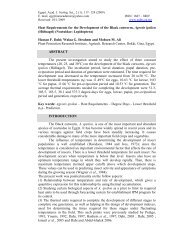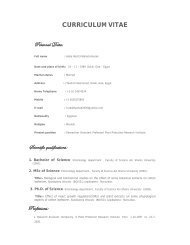Patterns of rainfall and incidence of malaria in Purnia district (Bihar ...
Patterns of rainfall and incidence of malaria in Purnia district (Bihar ...
Patterns of rainfall and incidence of malaria in Purnia district (Bihar ...
Create successful ePaper yourself
Turn your PDF publications into a flip-book with our unique Google optimized e-Paper software.
Egypt. Acad. J. Biolog. Sci., 5(1): 193-195 (2012) A. Entomology<br />
Email: egyptianacademic@yahoo.com ISSN: 1687–8809<br />
Received: 15/6/2012 www.eajbs.eg.net<br />
<strong>Patterns</strong> <strong>of</strong> <strong>ra<strong>in</strong>fall</strong> <strong>and</strong> <strong><strong>in</strong>cidence</strong> <strong>of</strong> <strong>malaria</strong> <strong>in</strong> <strong>Purnia</strong> <strong>district</strong> (<strong>Bihar</strong>), India<br />
Ranjana Kumari <strong>and</strong> B. N. P<strong>and</strong>ey<br />
Eco-Genetical Research Laboratory P.G. Department <strong>of</strong> Zoology Purnea College<br />
<strong>Purnia</strong>, <strong>Bihar</strong> (India)<br />
E-mail b.n.p<strong>and</strong>ey@hotmail.com<br />
ABSTRACT<br />
A study was carried out to f<strong>in</strong>d out co-relation between <strong>ra<strong>in</strong>fall</strong> <strong>and</strong><br />
<strong>in</strong>stances <strong>of</strong> <strong>malaria</strong> <strong>in</strong>fection <strong>in</strong> different villages <strong>of</strong> <strong>Purnia</strong> <strong>district</strong> . The study<br />
clearly <strong>in</strong>dicates that there occurs a high positive co-relation between <strong>ra<strong>in</strong>fall</strong> <strong>and</strong><br />
<strong>in</strong>stances <strong>of</strong> <strong>malaria</strong> <strong>in</strong> the studied villages <strong>of</strong> the <strong>district</strong>. There occurs a gradual<br />
<strong>in</strong>crease <strong>in</strong> <strong>in</strong>stances <strong>of</strong> <strong>malaria</strong> with gradual rise <strong>in</strong> <strong>ra<strong>in</strong>fall</strong>s. The study also <strong>in</strong>dicates<br />
that besides <strong>ra<strong>in</strong>fall</strong>, ambient temperature also plays a key role <strong>in</strong> the <strong><strong>in</strong>cidence</strong> <strong>of</strong><br />
<strong>malaria</strong> as <strong>in</strong> certa<strong>in</strong> months the <strong><strong>in</strong>cidence</strong> <strong>of</strong> <strong>malaria</strong> was not found hav<strong>in</strong>g but<br />
<strong>ra<strong>in</strong>fall</strong>. Maximum <strong><strong>in</strong>cidence</strong> <strong>of</strong> <strong>malaria</strong> was noticed dur<strong>in</strong>g ra<strong>in</strong>y season followed by<br />
summer <strong>and</strong> w<strong>in</strong>ter seasons.<br />
INTRODUCTION<br />
Ra<strong>in</strong>fall plays an important role <strong>in</strong> <strong>malaria</strong> as it <strong>in</strong>creases relative humidity <strong>and</strong><br />
thereby the longevity <strong>of</strong> the adult mosquitoes, besides provid<strong>in</strong>g water as the medium for<br />
aquatic stages <strong>of</strong> the mosquitoes (McMichael <strong>and</strong> Martens, 1995). No doubt, <strong>ra<strong>in</strong>fall</strong><br />
provides breed<strong>in</strong>g ground <strong>of</strong> the mosquitoes, if it is moderate while it destroys breed<strong>in</strong>g<br />
sites <strong>and</strong> flush out larvae, when it is <strong>in</strong> excess. Ra<strong>in</strong>fall provides breed<strong>in</strong>g sites for<br />
mosquitoes to lay their eggs, <strong>and</strong> ensures a suitable relative humidity <strong>of</strong> at least 50 to 60%<br />
to prolong mosquito survival (Reiter, 2001). Many workers have reported a positive<br />
correlation between <strong>ra<strong>in</strong>fall</strong> <strong>and</strong> the <strong><strong>in</strong>cidence</strong> <strong>of</strong> Plasmodium falciparum (Gupta, 1996<br />
<strong>and</strong> Bouma et al.; 1996).<br />
Among vector born diseases, <strong>malaria</strong> is known to be <strong>in</strong>fluence by special <strong>and</strong><br />
temporal changes <strong>in</strong> the ambient environment, <strong>and</strong> caused by climatic factor through<br />
distribution <strong>of</strong> carrier vector <strong>and</strong> pathogens. Malaria is one <strong>of</strong> the oldest <strong>and</strong> major health<br />
problem <strong>of</strong> the world. It has now been identified as the disease most likely affected by<br />
climatic changes (WHO; WMO; UNEP, 1996). Climate variability <strong>and</strong> breed<strong>in</strong>g activity<br />
<strong>of</strong> anopheles are concerned one <strong>of</strong> the important environmental contributors <strong>of</strong> <strong>malaria</strong><br />
transmission (Pemola <strong>and</strong> Jauhari; 2006). There is dearth <strong>of</strong> literature on climatic variable<br />
<strong>and</strong> <strong>malaria</strong> transmission from India. A few studies has reported the role <strong>of</strong> factors like<br />
urbanization, irrigation, location <strong>of</strong> houses, habits <strong>of</strong> sleep<strong>in</strong>g outside, rear<strong>in</strong>g <strong>of</strong> animals<br />
as well as dra<strong>in</strong>age system on the <strong>malaria</strong> <strong><strong>in</strong>cidence</strong>. (Batra et al. 2001, Joshi et al. 2005,<br />
Sa<strong>in</strong>i et al. 2009 <strong>and</strong> P<strong>and</strong>ey et al. 2011). Keep<strong>in</strong>g this aim <strong>in</strong> m<strong>in</strong>d, the present work<br />
was under taken to explore the extent <strong>of</strong> relationship <strong>of</strong> <strong>ra<strong>in</strong>fall</strong> with <strong>in</strong>stances <strong>of</strong> <strong>malaria</strong><br />
<strong>in</strong> rural areas <strong>of</strong> <strong>Purnia</strong> <strong>district</strong>.<br />
MATERIALS AND METHODS<br />
Study areas:<br />
The present study was carried out <strong>in</strong> different villages <strong>of</strong> <strong>Purnia</strong> <strong>district</strong>. <strong>Purnia</strong><br />
is one <strong>of</strong> the oldest <strong>district</strong> <strong>of</strong> <strong>Bihar</strong> which live at 25 0 -24 0 <strong>and</strong> 26 0 -7 0 north latitude <strong>and</strong><br />
86 0 -39 0 <strong>and</strong> 88 0 -3 0 west longitude. The <strong>district</strong> is located at height <strong>of</strong> 315 meters from
194<br />
Ranjana Kumari <strong>and</strong> B. N. P<strong>and</strong>ey<br />
the sea level. The <strong>district</strong> is reach <strong>in</strong> flora <strong>and</strong> fauna. It is popularly known as Poor’s<br />
man Drajeel<strong>in</strong>g . As per Indian census report <strong>of</strong> 2011, the population <strong>of</strong> <strong>Purnia</strong> is<br />
about 3273127 (M -1695815 , F – 1577298 ).<br />
Meterological data:<br />
Daily <strong>ra<strong>in</strong>fall</strong> (mm) was recorded <strong>and</strong> pooled for all the months from June 2010<br />
to May 2011.<br />
Epidemiological data:<br />
Epidemiological surway was conducted to collect the <strong>in</strong>formation regard<strong>in</strong>g<br />
<strong>malaria</strong> <strong>in</strong>fected persons <strong>in</strong> purnia <strong>district</strong>, from private pathology centar ,hospitals<br />
,<strong>and</strong> PHC <strong>of</strong> purnia <strong>district</strong> . Door to door surway was also made to record the<br />
<strong>in</strong>stances <strong>of</strong> <strong>malaria</strong> <strong>in</strong>fection <strong>in</strong> study area.<br />
RESULT AND DISCUSSION<br />
Data <strong>of</strong> monthly <strong>ra<strong>in</strong>fall</strong> (mm) <strong>and</strong> <strong>in</strong>stances <strong>of</strong> <strong>malaria</strong> <strong>in</strong> purnia <strong>district</strong> are<br />
shown <strong>in</strong> table 1 <strong>and</strong> fig. 1. The result <strong>of</strong> the study show that except for colder months<br />
<strong>of</strong> the year (Nov to Feb), <strong>in</strong>fection <strong>of</strong> <strong>malaria</strong> was <strong>in</strong> rise dur<strong>in</strong>g rest <strong>of</strong> the eight<br />
months .The study revealed a tra<strong>in</strong>ed <strong>of</strong> rise from the month <strong>of</strong> May to August (Table<br />
-1 <strong>and</strong> Fig -1), When peak value <strong>of</strong> patients were found <strong>in</strong> the <strong>district</strong>. The <strong>in</strong>stance <strong>of</strong><br />
<strong>malaria</strong> started fall<strong>in</strong>g from September (Table 1 <strong>and</strong> Fig. 1).The <strong>in</strong>stances <strong>of</strong> <strong>malaria</strong><br />
<strong>in</strong>creases as the amount <strong>of</strong> <strong>ra<strong>in</strong>fall</strong> <strong>in</strong>creased.<br />
Table 1: Average monthly value <strong>of</strong> <strong>ra<strong>in</strong>fall</strong> <strong>and</strong> <strong>malaria</strong> cases <strong>in</strong> <strong>Purnia</strong> <strong>district</strong> dur<strong>in</strong>g the period <strong>of</strong><br />
Sept. 2010 to Aug. 2010.<br />
MONTHS RAINFALL <strong>in</strong> mm NO. OF POSITIVE CASES<br />
SEP. 2010 7.38 9<br />
OCT.2010 5.65 7<br />
NOV.2010 0.2 0<br />
DEC.2010 Trace 0<br />
JAN 2011 0.15 0<br />
FEB 2011 2.86 1<br />
MARCH2011 2.9 2<br />
APR2011 0.82 0<br />
MAY2011 4.33 5<br />
JUNE 2011 13.89 10<br />
JULY 2011 11.28 9<br />
AUG 2011 14.51 12<br />
Fig. 1: Average monthly value <strong>of</strong> <strong>ra<strong>in</strong>fall</strong> <strong>and</strong> <strong>malaria</strong> cases <strong>in</strong> <strong>Purnia</strong> <strong>district</strong> dur<strong>in</strong>g the period <strong>of</strong><br />
September 2010 to August 2010.
<strong>Patterns</strong> <strong>of</strong> <strong>ra<strong>in</strong>fall</strong> <strong>and</strong> <strong><strong>in</strong>cidence</strong> <strong>of</strong> <strong>malaria</strong> <strong>in</strong> <strong>Purnia</strong> <strong>district</strong> (<strong>Bihar</strong>), India 195<br />
The maximum cases <strong>of</strong> <strong>malaria</strong> where observed <strong>in</strong> ra<strong>in</strong>y season, when <strong>ra<strong>in</strong>fall</strong><br />
by maximum (Table -1) followed by summer <strong>and</strong> w<strong>in</strong>ter. The <strong><strong>in</strong>cidence</strong> <strong>of</strong> <strong>malaria</strong><br />
was maximum <strong>in</strong> the month <strong>of</strong> August followed by June <strong>and</strong> July. This clearly<br />
<strong>in</strong>dicate that there is positive co-relation between <strong><strong>in</strong>cidence</strong> <strong>of</strong> <strong>malaria</strong> <strong>and</strong> pattern <strong>of</strong><br />
<strong>ra<strong>in</strong>fall</strong>. Such type <strong>of</strong> co-relation has been found by many workers such as Pemola <strong>and</strong><br />
Jauhari; 2006, Battacharya et al. 2006, Rama samy et al., 1992, S<strong>in</strong>gh <strong>and</strong> Sharma<br />
2002 <strong>and</strong> Sa<strong>in</strong> et al. 2009.<br />
The <strong>malaria</strong> shows its appearance <strong>in</strong> the month <strong>of</strong> February, when amb<strong>in</strong>ent<br />
temperature is quite congenial for the parasite, vector as well as host.<br />
CONCLUSION<br />
On the basis <strong>of</strong> present study, it can be concluded that there is a positive<br />
co-relation between patterns <strong>of</strong> <strong>ra<strong>in</strong>fall</strong> <strong>and</strong> <strong>in</strong>stances <strong>of</strong> <strong>malaria</strong>. The <strong>in</strong>stances <strong>of</strong><br />
<strong>malaria</strong> show an <strong>in</strong>crease from the month <strong>of</strong> May atta<strong>in</strong><strong>in</strong>g its peak <strong>in</strong> the month <strong>of</strong><br />
August with <strong>in</strong>crease <strong>in</strong> the amount <strong>of</strong> <strong>ra<strong>in</strong>fall</strong>. Maximum number <strong>of</strong> <strong>malaria</strong> patients<br />
were found <strong>in</strong> ra<strong>in</strong>y season followed by summer <strong>and</strong> w<strong>in</strong>ter season. The present study<br />
also reveals that besides <strong>ra<strong>in</strong>fall</strong>, ambient temperature also plays a key role <strong>in</strong> the<br />
<strong>in</strong>stances <strong>of</strong> <strong>malaria</strong>.<br />
REFERENCES<br />
Batra, C. P. Adak, T. Sharma, V. P. <strong>and</strong> Mittal, P.K. (2001). Impact <strong>of</strong> urbanization<br />
on bionomics <strong>of</strong> A. culicifacies <strong>and</strong> A. stephensi <strong>in</strong> Delhi. Indian J. Malariol.<br />
Bhattacharya, S. Sharma, C. Dhiman, R. C. <strong>and</strong> Mitra, A.P (2006). Climate Change<br />
<strong>and</strong> <strong>malaria</strong> <strong>in</strong> India.<br />
Gill, C. A (1921). The role <strong>of</strong> meterology <strong>in</strong> <strong>malaria</strong>. Indian J. Med. Res.<br />
Joshi, V. Sharma, R.C.; S<strong>in</strong>ghi, M. S<strong>in</strong>gh, H. Sharma, K. Sharma, Y. <strong>and</strong> Adha S.<br />
(2005). Entomological studies on <strong>malaria</strong> <strong>in</strong> irrigated <strong>and</strong> non-irrigated areas<br />
<strong>of</strong> Thar desert, Rajasthan, Indian. J. Vect. Borne.<br />
Pemola, N. <strong>and</strong> Jauhari, R. K. (2006). Climatic variables <strong>and</strong> <strong>malaria</strong> Incidence <strong>in</strong><br />
Dehradun , Uttaranchal, India.<br />
Rama samy, R. Ramasamy, M. S. Wijesundera, D. A. Wijesundera, A. P. Dewit, I <strong>and</strong><br />
Ranas<strong>in</strong>ghe, C. (1992). High seasonal <strong>malaria</strong> transmission rates <strong>in</strong> the<br />
<strong>in</strong>termediate <strong>ra<strong>in</strong>fall</strong> Zone <strong>of</strong> srilanka.<br />
Sharma, R. S. Sharma, G. K <strong>and</strong> Dhillon, G. P. S (1996). In Epidemiology a <strong>malaria</strong><br />
<strong>in</strong> India. (Eds Sharma, R. S. Sharma, G. K. <strong>and</strong> Dillon, G. P. S) Government<br />
<strong>of</strong> India m<strong>in</strong>istry <strong>of</strong> Health <strong>and</strong> Family welfare.<br />
S<strong>in</strong>gh, R. P. S<strong>in</strong>gh, S. Jauhari, R. K. (1994). Incrim<strong>in</strong>ation <strong>of</strong> anopheles stephensi<br />
liston 1901 as a vector <strong>of</strong> <strong>malaria</strong> <strong>in</strong> South-eastern Doon Vally.<br />
Bouna, M. J; Dya C.; Van der Ky, H.J. (1996) Falciparum <strong>malaria</strong> <strong>and</strong> climate<br />
changes <strong>in</strong> the Northwest Frontier Prov<strong>in</strong>ce <strong>of</strong> Pakistan. Am. J. Trop. Med.<br />
Hyg; 55(2): 131-7.<br />
Gupta, R. (1996). Correlat<strong>in</strong> <strong>of</strong> <strong>ra<strong>in</strong>fall</strong> with upsurge <strong>of</strong> <strong>malaria</strong> <strong>in</strong> Rajasthan. J. Assoc.<br />
Phys. Ind., 44:385-9.<br />
Mc. Michael. A. J. <strong>and</strong> Martens, W. J. M. (1995). The health impact <strong>of</strong> global climate<br />
changes: grasp<strong>in</strong>g with scenario predictive models <strong>and</strong> multiple uncerta<strong>in</strong>ties.<br />
Ecosyst. Hlth., 1:23-33.<br />
Pampana, E. (1969). Ed. A text Book <strong>of</strong> Malaria Eradication. Oxford university press.<br />
London (U.K).
















